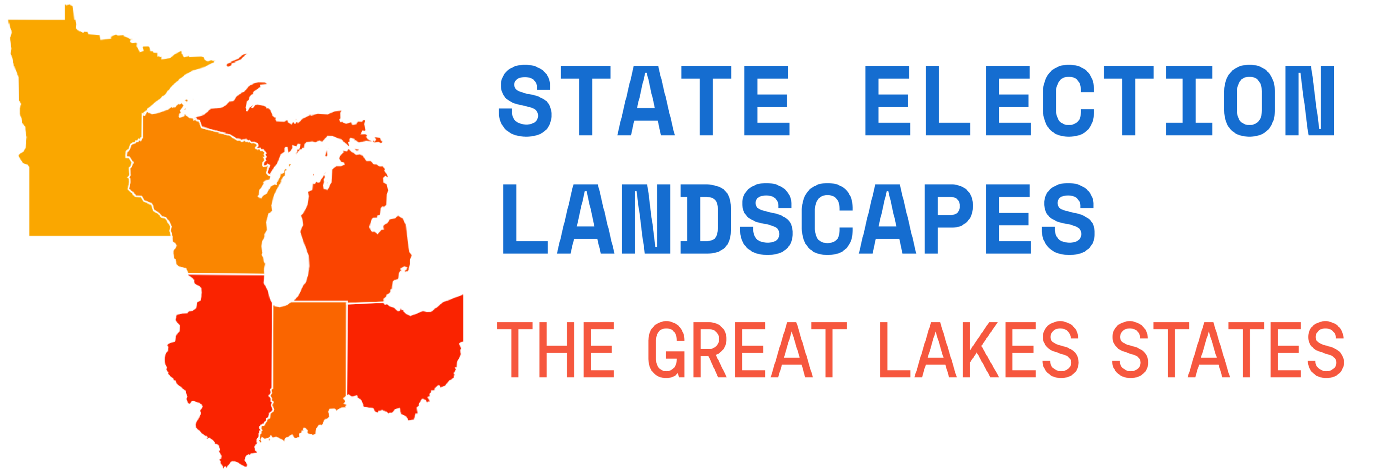Introducing: State Election Landscapes
An in-depth look at election administration in 6 states
Today, the MIT Election Lab is launching an exciting new project focused on election administration in a few of the coolest states in the U.S.
We mean “cool” literally, of course — the six states that are featured in this project are nestled around the Great Lakes, renowned for blustery wind and a fair amount of snow, especially this time of year.

For months, we’ve been working with academics and election officials around the region to collect an enhanced set of data and descriptive materials about the administration of elections in the six states of Illinois, Indiana, Michigan, Minnesota, Ohio, and Wisconsin. What does that mean? It means we’ve been compiling some important information, including:
- narrative material about the policies and legal ins & outs governing elections in each state,
- official information about the conduct of elections, and
- a visualization tool that helps display statistical information about elections since 2010.
We’re thrilled to launch all of that collected information today on our website, available at https://electionlab.mit.edu/landscapes.
Why these states?
Frosty jokes aside, there are a few reasons we started the project with these states. One reason is that the Great Lakes States are a microcosm of election practices throughout the United States. Some have election-day registration, others not; some issue a lot of provisional ballots, others not; some rely heavily on early voting, others not — and so on, and so on.
State policy choices like these are reflected in the state’s administrative outcomes, which makes the variation between states quite interesting from a research perspective. And on top of that, there are variations in how election laws and administrative choices impact counties within each state, too. We designed the data visualizations — which break down by the state and county level — to help researchers (and election officials) get a sense of these effects and serve as a jumping-off point for further research.
But MEDSL, we hear you say. You’re always talking about election administration and data. What makes this different than your other projects?
We’re so glad you asked! With the Election Landscapes project, we hope to provide detailed information — and data — beyond what we’ve been able to offer before. For one, the narrative information on laws and policies goes far beyond anything we’ve attempted in the past. By breaking down the data visualizations to the county level, we’re also able to offer a much more detailed look at data, and more descriptive information about what’s happening within states, not just between them.
Who’s involved?
At its heart, this project is a collaborative effort to fill our collective knowledge gaps about the conduct of elections. We would never have been able to bring it to life by ourselves.
Election Landscapes: The Great Lakes States is the result of work done by Barry Burden at the University of Wisconsin Election Research Center, Doug Chapin of the University of Minnesota and Fors Marsh Group, Steven Huefner and Edward Foley at The Ohio State University’s Moritz College of Law, and MEDSL’s own Charles Stewart.
Beyond the principle collaborators, we worked with election officials in all six states who gave their recommendations, sent along information, and asked questions that made the final product better. The Joyce Foundation, which is based in and focused on the Great Lakes region, provided generous support to get the Election Landscapes project off the ground.
What’s next?
For our own part, we’ll continue adding to it; first by supplementing the information already there, and eventually by adding new states to the fold. And, of course, we’ll keep talking about election administration, and will continue to feature the information in the Election Landscapes site in our analysis of elections past and quickly approaching.
Now that the project is out in the wide world, though, we hope you’ll take full advantage of the information it offers! We’re looking forward to many more conversations and new research ideas to come.
